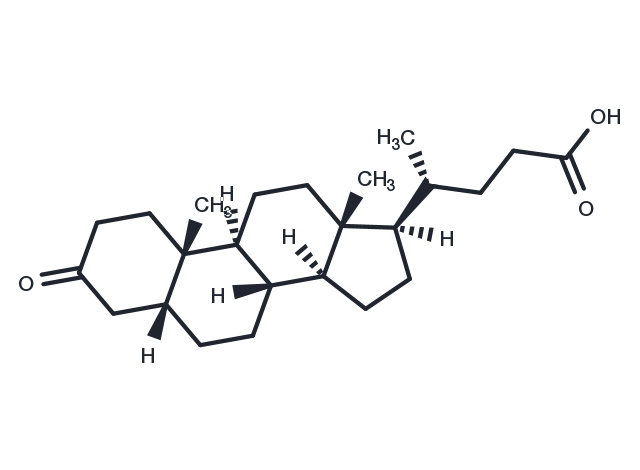Powder: -20°C for 3 years | In solvent: -80°C for 1 year


3-Oxo-5β-cholanoic acid (Dehydrolithocholic acid) (Dehydrolithocholic acid) is a bile acid metabolite and inhibits the differentiation of TH17 cells by directly binding to the key transcription factor RORγt (Kd: 1.13 μM).

| Pack Size | Availability | Price/USD | Quantity |
|---|---|---|---|
| 10 mg | In stock | $ 41.00 | |
| 25 mg | In stock | $ 63.00 | |
| 50 mg | In stock | $ 91.00 | |
| 1 mL * 10 mM (in DMSO) | In stock | $ 46.00 |


| Description | 3-Oxo-5β-cholanoic acid (Dehydrolithocholic acid) (Dehydrolithocholic acid) is a bile acid metabolite and inhibits the differentiation of TH17 cells by directly binding to the key transcription factor RORγt (Kd: 1.13 μM). |
| In vitro | Treatment with 3-Oxo-5β-cholanoic acid notably diminishes the RORγt reporter's activity, likely through direct interaction with RORγt, thereby hindering TH17 cell differentiation by suppressing its transcriptional activity. |
| In vivo | 3-Oxo-5β-cholanoic acid (Dehydrolithocholic acid) (0.3% (w/w); p.o.; for 1 week) significantly reduces the percentage of ileal TH17 cells[1]. |
| Synonyms | Dehydrolithocholic acid |
| Molecular Weight | 374.56 |
| Formula | C24H38O3 |
| CAS No. | 1553-56-6 |
Powder: -20°C for 3 years | In solvent: -80°C for 1 year
DMSO: 65 mg/ml (173.54 mM), Sonication is recommended.
You can also refer to dose conversion for different animals. More
bottom
Please see Inhibitor Handling Instructions for more frequently ask questions. Topics include: how to prepare stock solutions, how to store products, and cautions on cell-based assays & animal experiments, etc.
3-Oxo-5β-cholanoic acid 1553-56-6 Metabolism ROR cell factor RAR-related orphan receptor 3 Oxo 5β cholanoic acid TH17 RORγt 3-Oxo-5b-cholanoic acid differentiation acid bile Inhibitor responses transcription inhibit Dehydrolithocholic acid 3-Oxo-5beta-cholanoic acid 3Oxo5βcholanoic acid immune 3-oxoLCA inhibitor
